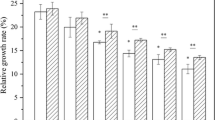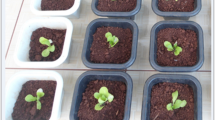Summary
Distribution of radiochromium at the plant and cellular levels varies with the chemical form added to the nutrient medium. Cr EDTA is less absorbed and metabolized by the roots than Cr+++ and CrO4 −− but its translocation rate is clearly higher.
More than 99 percent of the Cr+++ and CrO4 −− absorbed remained bound in the roots and in the concentration range used absorption was proportional to the nutrient solution content.
Protoplasmic fractions of roots contained the highest percentage of Cr+++ and CrO4 −− activities except when the level of Cr+++ added was 1 ppm (maximum permissible level for the cationic form). In that case cell walls constitute a serious barrier and like for Zn++ the mechanism of tolerance would reside in cation binding sites in the cell wall components.
Cr is bound to the different proteins isolated from the protoplasm and the results obtained confirm the non-specificity of such a process.
Similar content being viewed by others
References
Bertrand D. and De Wolf A., Le chrome, oligoélément dynamique pour les végétaux supérieurs. Compt. Rend. 261, 5616–5617 (1965).
Bertrand D. and De Wolf A., Necessité de l'oligoélément chrome pour la culture de la pomme de terre. Compt. Rend. 266, 1494 (1968).
Canter L. W. and Gloyna E. F., Radioactivity transport in water, transport of Cr-51 in an aqueous environment. U.S. Atome Energy Comm. Tech. Rept. 11, 230 pp. (1967).
Cesaretti, C. M., Inquinamento ed Agricultura. ISVET 30. Ed.F. Angeli Milano (1970).
DeKock P. C., Heavy metal toxicity and iron chlorosis. Ann. Botany 20, 133–141 (1956).
Diez-Altares C. and Bornemisza E., The localization of zinc-65 in germinating corn tissues. Plant and Soil 26, 175–187 (1967).
Hewitt E. J., Relation of manganese and some other metals to the iron status of plants. Nature 161, 489–490 (1948).
Hewitt E. J., Metal interrelationships in plant nutrition. I. Effects of some metal toxicities on sugar beet, tomato, oat, potato, and marrowstem kale grown in sand culture. J. Exp. Botany 4, 59–64 (1953).
Lyon G. L. Brooks R. R. Peterson P. J., and Butler G. W., Trace elements in a New Zealand serpentine flora. Plant and Soil. 29, 225–240 (1968).
Lyon G. L., Peterson P. J. and Brooks R. R., Chromium-51 transport in the xylem sap of Leptospermum scoparium (Manuka). New Zealand Sci. 12, 541–545 (1969).
Mertz, W., Biological role of chromium. In Trace Elements in Nutrition, 50th Ann. Meet. Fed. Ann. Soc. Exp. Biol. Atlantic City 1966 26, 186–193 (1967).
Nougarede, A., Biologie Végétale. I. Cytologie, Masson et Cré Ed., 598 pp. (1969).
Myttenaere, C., Chromium absorption by tomato plants (Lycopersicum esculentum): influence of the chemical form and level on its metabolism following root absorption. Intern Rept. Biol. Div. CCR Euratom Ispra Italy (1972).
Persson L., Labile-bound sulfate in wheat-roots: localization, nature and possible connection to the active absorption mechanism. Physiol Plantarum 22, 959–76 (1969).
Peterson P. J., The distribution of zinc-65 in Agrostis tenuis Sibth, and A. Stolonifera L. tissues. J. Exp. Botany 20. 863–875 (1969).
Pettersson S., Active and passive components of sulfate uptake in sunflower plants. Physiol Plantarum 19, 459–492 (1966).
Roberts K. R. and Marzluf G. A., The specific interacrion of chromate with the dual sulfate permease systems of Neurospora crassa. Arch. Biochem. Biophys. 142, 651–659 (1971).
Tiffin L. O., and Brown J. C., Selective absorption of iron chelates by soybean plants. Plant Physiol 36, 710–714 (1961).
Turner, R. G. and Gregory, R. P. G., The use of radioisotopes to investigate heavy metal tolerance in plants. In Isotopes and Plant Nutrition and Physiology, IAEA, 493–509 (1967).
Turner M. A. and Rust R. H., Effects of chromium on growth and mineral nutrition of soybeans. Soil Sci. Soc. Am. Proc. 35, 755–758 (1971).
Verfaillie G., Physico-chemical considerations about the use of Hoagland-Arnon I nutrient solution in relation to chromium pollution studies. Rapp. Intern Assoc. Euratom-ITAL Wageningen (1972).
Author information
Authors and Affiliations
Additional information
This publication is contribution N. 847 of the Euratom Biology Division.
Rights and permissions
About this article
Cite this article
Myttenaere, C., Mousny, J.M. The distribution of chromium-51 in lowland rice in relation to the chemical form and to the amount of stable chromium in the nutrient solution. Plant Soil 41, 65–72 (1974). https://doi.org/10.1007/BF00017944
Issue Date:
DOI: https://doi.org/10.1007/BF00017944




